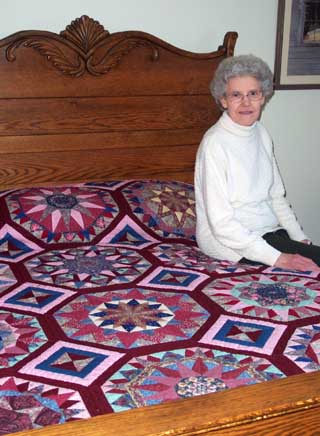
one stitch at a time Quilter Arleen Boyd says she developed her talents with a needle and thread the old fashioned way - practice, practice, practice. "I've always sewed. My mother passed away when I was 12 years old and I started making my own clothes. I've been sewing ever since," Boyd says. In 1980, she took her first quilting class at Greece Continuing Education. She saw a "quilt as you go" quilt project and thought that it looked like fun; she has been having fun with quilting ever since. Arleen has developed her quilting skills to the point where she now is teaching quilting to others. She teaches six or seven classes a year at area quilt shops, quilt shows and quilting seminars. "I always like to explore what is new in quilting techniques, I'm looking for new ideas, and that is what I like to teach, the new stuff," Boyd says. For the last 20 years, Ellen Farnham has co-coordinated the North Chili Quilt Show held each fall at the United Methodist Church of North Chili. She is well acquainted with Arleen Boyd. "Arleen is a frequent teacher and workshop leader during our show. She has a quiet way of simplifying things that look complicated. She knows how to make things approachable. She is truly generous in her teaching and she is extremely helpful to those new to quilting," Farnham says. Arleen is also a frequent contributor to the North Chili Quilt Show and was the featured quilter at last year's show. Farnham says of her work, "Her stitch is so meticulous that very often visitors to the show really don't believe that her stitch is hand stitchery. It is so beautiful." Developing a style Boyd's advice for developing the perfect hand quilted stitch is "practice, practice, practice." Whether it is stitching, color choice or design," just keep doing it and take all the classes you can because there is always something new to learn," she says. The sewing room The impact of Boyd's sewing room is first of all, color. All her fabrics are sorted into stacks defined by color, one stack per color, except for blue, of which there are three stacks. A design board on the wall is a quilt block experiment display. On the board the day of the visit for this article was a "Quilt With a View" block in preparation for a class she taught last month at The Quilting Parlor in Churchville, and a reverse appliqué block, a technique demonstrated in a book she recently purchased. "I love trying new techniques, and there is always something new in the quilting world, that's what makes it so much fun,' Boyd says. There was also an origami block that applies the ancient paper folding technique of origami to fabric, an original eight inch block of fabric after folding results in a four inch block. Origami-like technique is also new in the quilt world. In her sample Boyd used a water color dyed fabric which, when used in beautiful colors and in pleasing combinations, contributes to the beauty of the finished block. Boyd has already begun teaching this technique in her classes. She also has what she calls "think about it" piles. These are stacks of fabrics that are in the design process where she is placing fabrics together based on how the fabrics look next to one another. "I add and subtract to the piles depending on how I feel about how it looks, you just know when it is right because you feel it," she says. Boyd doesn't use the usual tools to combine colors such as the color wheel. She makes her selections based on how she feels about them and that is what she advises her students to do. "I start with a fabric I love and go from there with putting a quilt block together," she says. How Boyd sees color is as an individual interpretation. She held up a blue/green/teal swatch of fabric and said, "What color is this? Some say blue, some green, so it's how you see it." A valuable lesson on color theory from one who understands. When asked about a small stack of quilt blocks made from all different colors and sizes of pieces of fabric, Boyd explains that those are blocks made from her scrap fabric. She sews the pieces together in blocks and gives them to the sewers of Hope Lutheran Church in Greece. They assemble the blocks into quilts that are donated to their world wide refugee relief program. A true competitor Boyd usually doesn't travel with her quilts, she mails them off to shows and from there the quilts speak for themselves. How to end the day |
